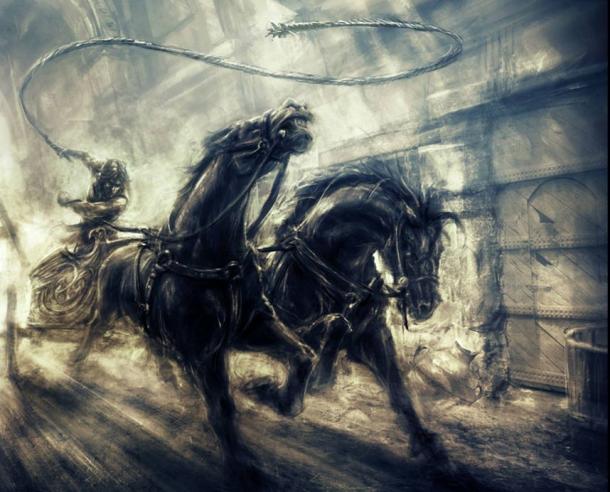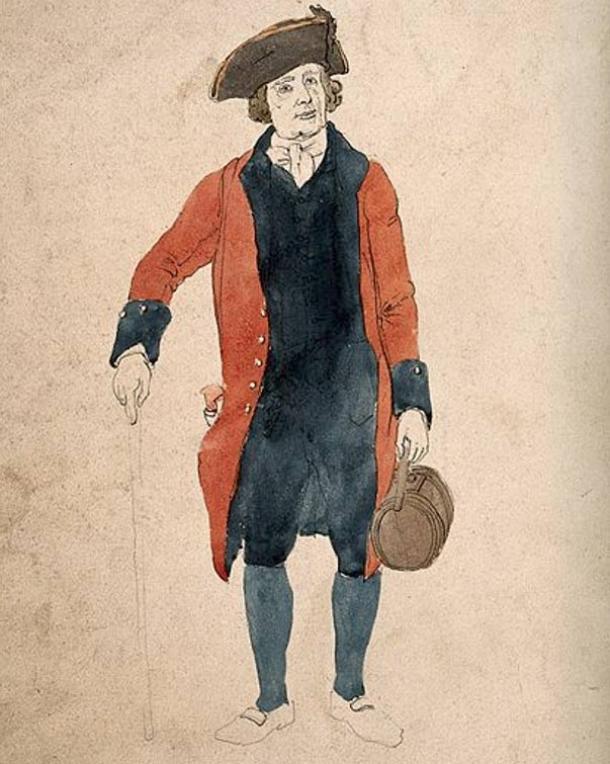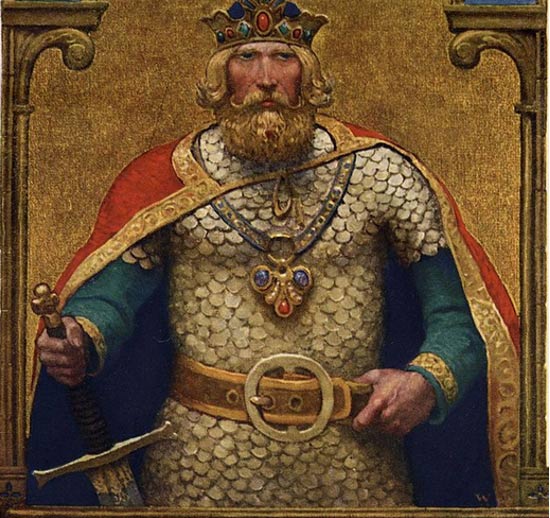The ‘Thirteen Treasures of Britain’ are a group of magical items found in late medieval Welsh tradition. These precious relics are mentioned in 15th and 16th century manuscripts, such as the Welsh Arthurian tale of ‘Culhwch and Olwen’. The Thirteen Treasures are said to have been located in the north of the British Isles, i.e. northern England and Scotland. One of the Welsh manuscripts is in fact entitled ‘Tri Thlws ar Ddeg Ynys Prydain’, which has been translated into English as ‘The Names of the Thirteen Treasures of the Island of Britain, which were in the North’.
The Thirteen Legendary Treasures of Britain
Ancient Origins
13 April 2015
The ancient Greek writer Hesiod once wrote that there were five ages of mankind – the Golden Age, the Silver Age, the Bronze Age, the Heroic Age, and the Iron Age. Similarly, in Hinduism, there are four different epochs – the Satya Yuga, Treta Yuga, Dwapar Yuga and Kali Yuga. In both Greek mythology and Hinduism, the ages preceding our present age are described as much more pleasant, with humanity experiencing deterioration over the ages. Likewise, in early British legends, it is said that the British Isles were, in a bygone age, the home of gods and heroes. Although these figures no longer dwell on the British Isles, legends sprung up about the magical objects these beings left behind.
The ‘Thirteen Treasures of Britain’ are a group of magical items found in late medieval Welsh tradition. These precious relics are mentioned in 15th and 16th century manuscripts, such as the Welsh Arthurian tale of ‘Culhwch and Olwen’. The Thirteen Treasures are said to have been located in the north of the British Isles, i.e. northern England and Scotland. One of the Welsh manuscripts is in fact entitled ‘Tri Thlws ar Ddeg Ynys Prydain’, which has been translated into English as ‘The Names of the Thirteen Treasures of the Island of Britain, which were in the North’.
The thirteen legendary treasures of Britain are as follows:
1. Dyrnwyn, gleddyf Rhydderch Hael (White-Hilt, the Sword of Rhydderch the Generous)
This peculiar sword belonged to Rhydderch Hael, a 7th century ruler of Alt Clut, a Brittonic kingdom in what is now Strathclyde, Scotland. When the sword was drawn by a worthy man, it would burst into flames from its hilt to its tip. Although Rhydderch was willing to lend his sword to anyone who asked for it, the recipients would reject it after learning of the sword’s strange quality.
 2. Mwys Gwyddno Garanir (The Hamper of Gwyddno Long-Shank)
2. Mwys Gwyddno Garanir (The Hamper of Gwyddno Long-Shank)
Gwyddno Long-Shank was the ruler of Canolbarth, a legendary sunken land off the coast of Wales (now Cardigan Bay), who possessed a magical hamper, a wicker basket that could multiply food. Known as the ‘basket of plenty’, food for one man would be placed into the hamper and then closed. When the basket was opened again, there would be enough food for a hundred men.

According to Welsh legend, this horn once belonged to Hercules, who acquired the object from the head of the centaur Nessus after he was slain by the hero. The horn was able to grant whatever drink a user wished to find within it.

Morgan, the king of Glamorgan, was the grandson and probable successor of King Meurig, who ruled over the early Welsh kingdoms of Gwent and Glywysing sometime between 400 and 600 AD. Morgan was said to have possessed a chariot that could travel quickly to any destination desired by its user.
 5. Kebystr Klydno Eiddin (The Halter of Clydno Eiddyn)
5. Kebystr Klydno Eiddin (The Halter of Clydno Eiddyn)
The fifth treasure was a halter fixed to a staple at the foot of the bed of Clydno Eiddin, a ruler in the Hen Ogledd, the Brythonic-speaking area in what is now northern England and southern Scotland during the Early Middle Ages. "Eiddyn" is the Brythonic name for Edinburgh, implying a connection to that territory. According to legend, whatever horse Clydno wished for, it would appear in the halter.

Llawfrodedd Farchog was a hero of Welsh tradition and a legendary figure in Arthur’s court in the tales of Culhwch and Olwen and Breuddwyd Rhonabwy. He is mentioned in Trioedd Tnys Prydein as the owner of a knife that would serve a company of 24 men at a dinner table, named as one of the Thirteen Treasures. The knife was great for a feast, but was also said to be a deadly weapon on the battlefield.
 7. Pair Dyrnwch Gawr (The Cauldron of Dyrnwch the Giant)
7. Pair Dyrnwch Gawr (The Cauldron of Dyrnwch the Giant)
This cauldron, which belonged to the Welsh god Dyrnwch, would quickly boil meat placed in it by a brave man. The meat placed in it by a coward, however, will never boil. Thus, the cauldron would reveal who was brave and who was cowardly.

Tudwal is thought to have been a ruler of Alt Clut, later known as Strathclyde, a Brittonic kingdom in the Hen Ogledd or "Old North" of Britain. He probably ruled sometime in the mid-6th century. If a brave man sharpened his sword on his whetstone, a man whose blood was drawn from this sword would die. The whetstone would have no effect on the sword of a cowardly man.

9. Pais Badarn Beisrydd (The Coat of Padarn of the Scarlet Robe)
Historical sources suggest Padarn Beisrudd ap Tegid was a Romano-British official of high rank who had been placed in command of Votadini troops stationed in Clackmannanshire in the 380s or earlier by the Emperor Magnus Maximus. Alternatively, he may have been a frontier chieftain in the same region who was granted Roman military rank. His red coat, one of the Thirteen Treasures, was said to perfectly fit a well-born man, regardless of his size. It would not, however, fit a common person.
 10. and 11. Gren a desgyl Rhygenydd Ysgolhaig (The Crock and the Dish of Rhygenydd the Cleric)
10. and 11. Gren a desgyl Rhygenydd Ysgolhaig (The Crock and the Dish of Rhygenydd the Cleric)
Whatever food a user wishes for, it would be found in the crock and dish.

Gwenddoleu ap Ceidio or Gwenddolau was a 6th century Brythonic king who ruled in Arfderydd (now Arthuret, Cumbria). This is in what is now south-west Scotland and north-west England in the area around Hadrian's Wall and Carlisle during the sub-Roman period in Britain. His chessboard of gold and silver was said to play any opponent on its own.
 13. Llen Arthyr yng Nghernyw (The Mantle of Arthur in Cornwall)
13. Llen Arthyr yng Nghernyw (The Mantle of Arthur in Cornwall)
King Arthur's llen or mantle is said to make anyone underneath it invisible, though able to see out. This item is known from two sources, the prose tales Culhwch and Olwen (c. 1100) and The Dream of Rhonabwy (early 13th century).

In some lists, the crock and dish of Rhygenydd are regarded as a set, thus counting as one item. Additionally, one of the items on the original list would be replaced with either the Mantle of Tegau Eurfron ‘Gold-Breast’, or the Stone and Ring of Eluned the Fortunate, thus bringing the number of treasures back to thirteen.
In the Welsh legends, the Thirteen Treasures were eventually acquired by Myrrdin (introduced into Arthurian legends as Merlin). The bearers of each treasure agreed to hand over their magical items to Myrrdin if he succeeded in obtaining the Horn of Bran, which they thought impossible. Myrrdin, however, got the horn from Bran, and with the other treasures, went into the Glass House / Tower, where they are said to remain until the return of King Arthur.
All images are representational only.
The Thirteen Legendary Treasures of Britain
Ancient Origins
13 April 2015
The ancient Greek writer Hesiod once wrote that there were five ages of mankind – the Golden Age, the Silver Age, the Bronze Age, the Heroic Age, and the Iron Age. Similarly, in Hinduism, there are four different epochs – the Satya Yuga, Treta Yuga, Dwapar Yuga and Kali Yuga. In both Greek mythology and Hinduism, the ages preceding our present age are described as much more pleasant, with humanity experiencing deterioration over the ages. Likewise, in early British legends, it is said that the British Isles were, in a bygone age, the home of gods and heroes. Although these figures no longer dwell on the British Isles, legends sprung up about the magical objects these beings left behind.
The ‘Thirteen Treasures of Britain’ are a group of magical items found in late medieval Welsh tradition. These precious relics are mentioned in 15th and 16th century manuscripts, such as the Welsh Arthurian tale of ‘Culhwch and Olwen’. The Thirteen Treasures are said to have been located in the north of the British Isles, i.e. northern England and Scotland. One of the Welsh manuscripts is in fact entitled ‘Tri Thlws ar Ddeg Ynys Prydain’, which has been translated into English as ‘The Names of the Thirteen Treasures of the Island of Britain, which were in the North’.
The thirteen legendary treasures of Britain are as follows:
1. Dyrnwyn, gleddyf Rhydderch Hael (White-Hilt, the Sword of Rhydderch the Generous)
This peculiar sword belonged to Rhydderch Hael, a 7th century ruler of Alt Clut, a Brittonic kingdom in what is now Strathclyde, Scotland. When the sword was drawn by a worthy man, it would burst into flames from its hilt to its tip. Although Rhydderch was willing to lend his sword to anyone who asked for it, the recipients would reject it after learning of the sword’s strange quality.

Gwyddno Long-Shank was the ruler of Canolbarth, a legendary sunken land off the coast of Wales (now Cardigan Bay), who possessed a magical hamper, a wicker basket that could multiply food. Known as the ‘basket of plenty’, food for one man would be placed into the hamper and then closed. When the basket was opened again, there would be enough food for a hundred men.

The Basket of Plenty would multiply its contents, providing food for one hundred men. ‘Apfelernte’ by Karl Vikas (Wikimedia Commons)
3. Korn Bran Galed o'r Gogledd (The Horn of Bran the Niggard from the North)
According to Welsh legend, this horn once belonged to Hercules, who acquired the object from the head of the centaur Nessus after he was slain by the hero. The horn was able to grant whatever drink a user wished to find within it.

The Horn of Bran was said to provide its owner with whichever drink they wished. Bearded Pictish warrior from the Bullion Stone, Angus, now in the National Museum of Scotland. (Wikimedia Commons)
4. Kar Morgan Mwynfawr (The Chariot of Morgan the Wealthy)
Morgan, the king of Glamorgan, was the grandson and probable successor of King Meurig, who ruled over the early Welsh kingdoms of Gwent and Glywysing sometime between 400 and 600 AD. Morgan was said to have possessed a chariot that could travel quickly to any destination desired by its user.

The fifth treasure was a halter fixed to a staple at the foot of the bed of Clydno Eiddin, a ruler in the Hen Ogledd, the Brythonic-speaking area in what is now northern England and southern Scotland during the Early Middle Ages. "Eiddyn" is the Brythonic name for Edinburgh, implying a connection to that territory. According to legend, whatever horse Clydno wished for, it would appear in the halter.

The magical horse halter of Clydno Eiddyn would grant Clydno with any horse he wished for (Wikimedia Commons)
6. Kyllell Llawfrodedd Farchog (The Knife of Llawfrodedd the Horseman)
Llawfrodedd Farchog was a hero of Welsh tradition and a legendary figure in Arthur’s court in the tales of Culhwch and Olwen and Breuddwyd Rhonabwy. He is mentioned in Trioedd Tnys Prydein as the owner of a knife that would serve a company of 24 men at a dinner table, named as one of the Thirteen Treasures. The knife was great for a feast, but was also said to be a deadly weapon on the battlefield.

This cauldron, which belonged to the Welsh god Dyrnwch, would quickly boil meat placed in it by a brave man. The meat placed in it by a coward, however, will never boil. Thus, the cauldron would reveal who was brave and who was cowardly.

The Cauldron of Dyrnwch the Giant would instantly cook the meat of a brave man (Wikimedia Commons)
8. Hogalen Tudwal Tutklyd (The Whetstone of Tudwal Tudglyd)
Tudwal is thought to have been a ruler of Alt Clut, later known as Strathclyde, a Brittonic kingdom in the Hen Ogledd or "Old North" of Britain. He probably ruled sometime in the mid-6th century. If a brave man sharpened his sword on his whetstone, a man whose blood was drawn from this sword would die. The whetstone would have no effect on the sword of a cowardly man.

The whetstone of Tudwal Tudglyd would imbue any sword sharpened on it with deathly qualities. (Wikimedia Commons)
9. Pais Badarn Beisrydd (The Coat of Padarn of the Scarlet Robe)
Historical sources suggest Padarn Beisrudd ap Tegid was a Romano-British official of high rank who had been placed in command of Votadini troops stationed in Clackmannanshire in the 380s or earlier by the Emperor Magnus Maximus. Alternatively, he may have been a frontier chieftain in the same region who was granted Roman military rank. His red coat, one of the Thirteen Treasures, was said to perfectly fit a well-born man, regardless of his size. It would not, however, fit a common person.

Whatever food a user wishes for, it would be found in the crock and dish.

The clay pot and dish of Rhygenydd the Cleric could produce any food the heart desired (Wikimedia Commons)
12. Gwyddbwyll Gwenddoleu ap Ceidio (The Chess board of Gwenddolau son of Ceidio)
Gwenddoleu ap Ceidio or Gwenddolau was a 6th century Brythonic king who ruled in Arfderydd (now Arthuret, Cumbria). This is in what is now south-west Scotland and north-west England in the area around Hadrian's Wall and Carlisle during the sub-Roman period in Britain. His chessboard of gold and silver was said to play any opponent on its own.

King Arthur's llen or mantle is said to make anyone underneath it invisible, though able to see out. This item is known from two sources, the prose tales Culhwch and Olwen (c. 1100) and The Dream of Rhonabwy (early 13th century).

The cloak of the legendary King Arthur is said to have the ability to make its wearer invisible (Wikimedia Commons)
In some lists, the crock and dish of Rhygenydd are regarded as a set, thus counting as one item. Additionally, one of the items on the original list would be replaced with either the Mantle of Tegau Eurfron ‘Gold-Breast’, or the Stone and Ring of Eluned the Fortunate, thus bringing the number of treasures back to thirteen.
In the Welsh legends, the Thirteen Treasures were eventually acquired by Myrrdin (introduced into Arthurian legends as Merlin). The bearers of each treasure agreed to hand over their magical items to Myrrdin if he succeeded in obtaining the Horn of Bran, which they thought impossible. Myrrdin, however, got the horn from Bran, and with the other treasures, went into the Glass House / Tower, where they are said to remain until the return of King Arthur.
All images are representational only.
Last edited:



